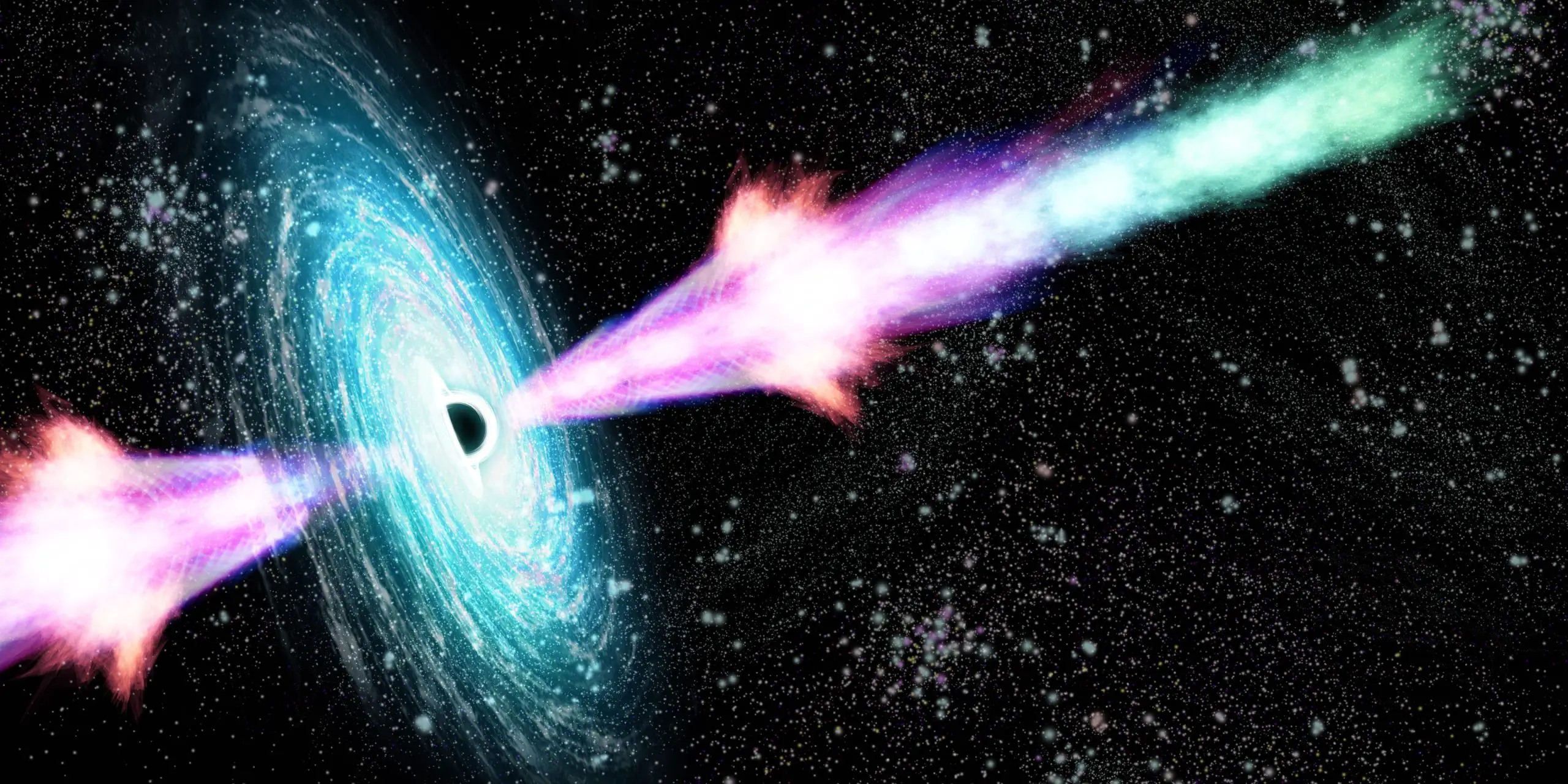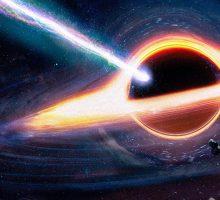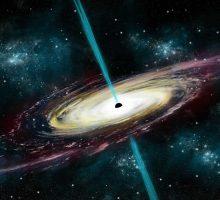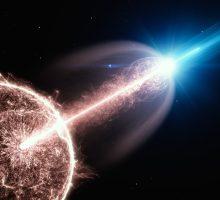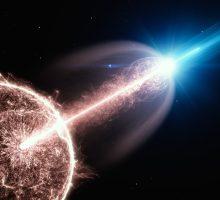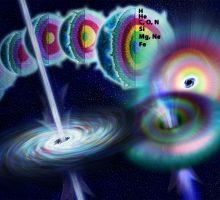- The Mystery of Gamma Ray Bursts: What We Know and What We Don’t
- Understanding the Origins of Gamma Ray Bursts: Theories and Hypotheses
- Gamma Ray Bursts: The Most Powerful Explosions in the Universe
- Probing the Universe with Gamma Ray Bursts: How They Help Us Understand the Cosmos
- The Different Types of Gamma Ray Bursts and What They Tell Us About the Universe
- Gamma Ray Bursts: Are They a Threat to Life on Earth?
- The Role of Satellites in Detecting and Studying Gamma Ray Bursts
- Gamma Ray Bursts and Black Holes: Exploring the Connection
- Gamma Ray Bursts and the Search for Alien Life
- Gamma Ray Bursts and the Future of Astrophysics Research.
- Conclusion
The Mystery of Gamma Ray Bursts: What We Know and What We Don’t
Gamma Ray Bursts (GRBs) are one of the most intriguing phenomena in astrophysics. They are brief but intense bursts of gamma-ray radiation that come from distant galaxies. Although scientists have been studying GRBs for several decades, there is still much we don’t know about them.
GRBs were first discovered in the late 1960s by the US military’s Vela satellites. Since then, many satellites have been launched to study GRBs, including NASA’s Swift and Fermi spacecraft. Thanks to these missions, we now know that GRBs come in two types: long-duration and short-duration. Long-duration GRBs last for more than two seconds, while short-duration GRBs last for less than two seconds.
The leading theory about the origin of long-duration GRBs is that they are produced when massive stars collapse and form black holes. Short-duration GRBs, on the other hand, are thought to be caused by the merger of two neutron stars or a neutron star and a black hole.
Despite the progress made in studying GRBs, there is still much we don’t understand about them. For example, scientists are still trying to determine what causes the initial burst of gamma rays and why the afterglow of the burst can last for days or even weeks. Additionally, it is not yet clear why some GRBs are accompanied by supernovae and others are not.
Understanding the Origins of Gamma Ray Bursts: Theories and Hypotheses
Gamma-ray bursts (GRBs) are among the most energetic phenomena in the universe. They release vast amounts of energy in the form of gamma-rays, which are the most energetic form of light. Despite being known for decades, the origins of GRBs are still not fully understood. Here we explore some of the theories and hypotheses that have been proposed to explain their origins.
One of the most popular theories is that long-duration GRBs are produced by the collapse of massive stars, which then form black holes. This process is called a supernova collapse. During this collapse, a massive amount of energy is released, which produces a burst of gamma-rays.
Another theory suggests that short-duration GRBs are caused by the merger of two neutron stars or a neutron star and a black hole. When these objects merge, they release a tremendous amount of energy in the form of gravitational waves, which in turn produce a burst of gamma-rays.
Other hypotheses have been proposed, such as the collision of a neutron star with a black hole or a white dwarf, but these are less well-supported by evidence.
There is also the possibility that there are multiple mechanisms at play that produce GRBs, and that they can occur in a variety of environments. This would explain why there are different types of GRBs that last for varying durations.
In summary, the origins of GRBs are still a topic of active research and debate. While there are several theories and hypotheses that attempt to explain these energetic events, much remains unknown. As we continue to study and learn more about these fascinating phenomena, we can expect to uncover new insights into the workings of the universe.
Gamma Ray Bursts: The Most Powerful Explosions in the Universe
Gamma-ray bursts (GRBs) are the most powerful explosions known in the universe. They release an enormous amount of energy in the form of gamma-rays, which are highly energetic photons. GRBs are so powerful that they can outshine entire galaxies for a brief period of time.
The energy released during a GRB is truly staggering. A single GRB can release as much energy in a few seconds as our Sun will emit over its entire lifetime. This makes them one of the most energetic events in the universe, surpassed only by the Big Bang itself.
The amount of energy released during a GRB can be measured in units of “ergs,” which are a measure of energy. To put this into perspective, a typical lightning bolt releases around one billion joules of energy, which is equivalent to about 10^10 ergs. In comparison, a typical long-duration GRB can release up to 10^54 ergs of energy.
The causes of these powerful explosions are still not fully understood, but scientists believe that they are produced by some of the most violent processes in the universe. As mentioned earlier, the leading theory is that long-duration GRBs are caused by the collapse of massive stars, which then form black holes. Short-duration GRBs are thought to be caused by the merger of two neutron stars or a neutron star and a black hole.
The study of GRBs has provided scientists with valuable insights into the workings of the universe. They have allowed us to better understand the processes that lead to the formation of black holes and the behavior of matter in extreme conditions.
Probing the Universe with Gamma Ray Bursts: How They Help Us Understand the Cosmos
Gamma-ray bursts (GRBs) are more than just spectacular displays of energy. They are also important tools that scientists can use to probe the universe and learn more about the cosmos. Here, we explore how GRBs help us better understand the universe.
Firstly, GRBs can be used to study the early universe. This is because they are so bright that they can be seen from extremely far away. This means that when we observe a GRB, we are essentially seeing back in time to when the universe was much younger. By studying the properties of GRBs, such as their duration and spectra, scientists can learn about the conditions in the early universe and how it has evolved over time.
Secondly, GRBs can be used to study the properties of matter in extreme conditions. During a GRB, matter is subjected to some of the most extreme conditions in the universe, such as high temperatures, strong magnetic fields, and intense radiation. By studying the behavior of matter in these conditions, scientists can better understand the laws of physics and how matter behaves under extreme circumstances.
Thirdly, GRBs can be used to study the properties of black holes. As mentioned earlier, the leading theory is that long-duration GRBs are produced by the collapse of massive stars, which then form black holes. By studying the properties of GRBs, scientists can learn more about how black holes form and evolve over time.
Finally, GRBs can be used to study the properties of galaxies. This is because GRBs are typically found in distant galaxies, and studying the properties of these galaxies can provide valuable insights into their formation and evolution.
The Different Types of Gamma Ray Bursts and What They Tell Us About the Universe
Gamma-ray bursts (GRBs) are some of the most violent and energetic events in the universe, and they come in two main types: long-duration GRBs and short-duration GRBs. In this blog, we will explore the different types of GRBs and what they tell us about the universe.
Long-duration GRBs are the more common type and last for more than two seconds. They are thought to be caused by the collapse of massive stars, which then form black holes. During the collapse, a massive amount of energy is released in the form of a jet of highly energetic particles, including gamma-rays. These jets are extremely narrow and highly collimated, meaning that they are focused into a tight beam that can travel for vast distances through the universe.
Short-duration GRBs, on the other hand, last for less than two seconds and are thought to be caused by the merger of two neutron stars or a neutron star and a black hole. These types of GRBs release a much smaller amount of energy than long-duration GRBs and have a different emission pattern.
Studying the different types of GRBs provides valuable insights into the workings of the universe. For example, long-duration GRBs are thought to be associated with the formation of black holes, which are some of the most extreme objects in the universe. By studying the properties of these bursts, scientists can learn more about the conditions that lead to the formation of black holes and how they evolve over time.
Short-duration GRBs, on the other hand, are thought to be associated with the mergers of compact objects, such as neutron stars and black holes. Studying these bursts can help us better understand the properties of these objects and how they interact with each other.
In addition, GRBs can also provide valuable insights into the properties of the universe itself. For example, the fact that we observe more long-duration GRBs in distant galaxies than in nearby galaxies tells us that these types of events were more common in the early universe. By studying the distribution of GRBs in the universe, scientists can learn more about the evolution of galaxies and the conditions that existed in the early universe.
Gamma Ray Bursts: Are They a Threat to Life on Earth
Gamma-ray bursts (GRBs) are some of the most powerful and energetic events in the universe. They release massive amounts of energy in the form of gamma-rays, which are highly energetic particles that can be harmful to life on Earth. In this blog, we will explore whether GRBs pose a threat to life on Earth.
Firstly, it is important to note that GRBs are extremely rare events. In fact, they are so rare that the chances of a GRB occurring in our galaxy during the lifetime of our solar system are extremely low. The nearest known GRB occurred in a galaxy over 3 billion light years away, which means that the gamma-rays would have been significantly weakened by the time they reached Earth.
However, even if a GRB were to occur in our galaxy, the likelihood of it causing significant harm to life on Earth is still low. This is because Earth’s atmosphere provides significant protection against gamma-rays. The atmosphere contains a layer of ozone, which absorbs most of the harmful ultraviolet radiation from the sun. This same layer would also provide significant protection against gamma-rays from a GRB.
In addition, life on Earth has survived numerous other cosmic events, such as supernovae and asteroid impacts. While these events can cause significant damage and even mass extinctions, life on Earth has shown remarkable resilience and has continued to thrive.
That being said, it is important to continue studying GRBs and their potential effects on life on Earth. By better understanding these events, we can develop strategies to mitigate any potential risks and protect life on our planet.
The Role of Satellites in Detecting and Studying Gamma Ray Bursts
Gamma-ray bursts (GRBs) are some of the most powerful and energetic events in the universe, and detecting and studying them is crucial for understanding the workings of the universe. Satellites play a crucial role in this endeavor, as they provide a unique vantage point for observing and studying GRBs. In this blog, we will explore the role of satellites in detecting and studying gamma-ray bursts.
Satellites are ideally suited for detecting GRBs because they can observe the entire sky, free from the interference of Earth’s atmosphere. In addition, satellites equipped with gamma-ray detectors are sensitive enough to detect even the faintest gamma-ray signals. The first satellite dedicated to studying GRBs was the Burst and Transient Source Experiment (BATSE) aboard NASA’s Compton Gamma Ray Observatory, which operated from 1991 to 2000. Since then, numerous other satellites, such as the Fermi Gamma-Ray Space Telescope and the Swift Gamma-Ray Burst Mission, have been launched and have made significant contributions to the study of GRBs.
Satellites are also crucial for studying the properties of GRBs in detail. By observing the afterglow of a GRB, scientists can learn about the environment in which the burst occurred and the mechanisms responsible for producing the gamma-rays. Satellites equipped with X-ray and optical telescopes can observe the afterglow in these wavelengths, providing additional insights into the properties of the burst.
One of the most exciting discoveries made possible by satellites is the detection of gravitational waves from the merger of two neutron stars, which was observed by the Laser Interferometer Gravitational-Wave Observatory (LIGO) and the Virgo observatory in 2017. This event was accompanied by a short-duration GRB, which was observed by multiple satellites. The detection of both the gravitational waves and the GRB provided a wealth of information about these extreme events, and paved the way for a new era of multi-messenger astronomy.
Gamma Ray Bursts and Black Holes: Exploring the Connection
Gamma-ray bursts (GRBs) are some of the most powerful and energetic events in the universe, and they are believed to be closely connected to black holes. In this blog, we will explore the connection between GRBs and black holes and how studying this connection can help us understand the universe.
Black holes are regions of space where the gravitational pull is so strong that nothing, not even light, can escape. They are formed when massive stars collapse in on themselves at the end of their lives. It is believed that GRBs are produced when the material surrounding a black hole is heated to extremely high temperatures and emits gamma-rays as it falls into the black hole.
There are two main types of GRBs: long-duration and short-duration. Long-duration GRBs are believed to be produced when a massive star collapses into a black hole. The collapse releases a burst of energy that is channeled into two narrow jets of matter that shoot out from the black hole at near-light speeds. Short-duration GRBs, on the other hand, are believed to be produced by the merger of two neutron stars or a neutron star and a black hole.
Studying the connection between GRBs and black holes can provide insights into the properties of black holes themselves. For example, by studying the afterglow of a GRB, scientists can learn about the properties of the material surrounding the black hole and the processes that occur as the material falls into the black hole. In addition, the detection of gravitational waves from the merger of two neutron stars or a neutron star and a black hole, accompanied by a short-duration GRB, provides a unique opportunity to study the properties of these extreme events and the role that black holes play in them.
Furthermore, studying the connection between GRBs and black holes can also provide insights into the evolution of galaxies. GRBs are believed to be associated with the formation of massive stars, which are found in young, star-forming galaxies. By studying the distribution and properties of GRBs, scientists can learn about the evolution of galaxies and the processes that drive star formation.
Gamma Ray Bursts and the Search for Alien Life
Gamma-ray bursts (GRBs) have been a topic of interest for scientists for decades, not only because they are one of the most powerful explosions in the universe, but also because they could potentially provide clues about the existence of alien life. In this blog, we will explore how GRBs could aid in the search for extraterrestrial life.
One of the primary ways that GRBs could be used in the search for alien life is by studying the chemical composition of the universe. GRBs are known to produce a significant amount of heavy elements such as gold and platinum, which are not formed in significant quantities by ordinary stellar processes. The presence of these elements in the universe could indicate that they were produced by supernovae or the collision of neutron stars, which are both sources of GRBs. By studying the distribution and abundance of these elements, scientists can gain insights into the history and evolution of the universe, which could in turn provide clues about the conditions necessary for the emergence of life.
Another way that GRBs could be used in the search for alien life is by studying their effects on planets in nearby star systems. GRBs release an enormous amount of energy, and if a planet were to be in the path of a GRB, the radiation could cause significant damage to the planet’s atmosphere and surface. However, it is also possible that the energy from a GRB could provide the necessary conditions for life to emerge. For example, the energy could create a temporary greenhouse effect on a planet, making it more habitable for life. By studying the effects of GRBs on nearby planets, scientists can gain insights into the conditions necessary for the emergence and survival of life.
Finally, GRBs could be used as a means of communication between civilizations. While the likelihood of two civilizations existing within close proximity is low, it is possible that a civilization could use a GRB to send a signal to another civilization. GRBs release an enormous amount of energy, and if a civilization were to direct a GRB in a specific direction, it could be detected by another civilization. By studying the properties of the GRB, scientists could potentially decipher a message sent by another civilization.
Gamma Ray Bursts and the Future of Astrophysics Research.
Gamma-ray bursts (GRBs) are some of the most powerful and mysterious events in the universe, and their study has led to groundbreaking discoveries in astrophysics. In this blog, we will explore how the study of GRBs has shaped the future of astrophysics research.
One of the most significant contributions of GRB research to astrophysics is the discovery of the connection between GRBs and supernovae. Scientists found that some GRBs are caused by the collapse of massive stars and the resulting supernova explosion. This discovery helped explain the origin of heavy elements in the universe and provided important insights into the evolution of stars.
Another significant development in GRB research is the use of GRBs as probes of the early universe. Because GRBs are incredibly bright, they can be detected from billions of light-years away. By studying the light emitted by these distant GRBs, scientists can learn about the composition and structure of the early universe, as well as the processes that led to the formation of galaxies.
The study of GRBs has also led to new advances in technology. The development of telescopes and detectors capable of detecting the high-energy radiation emitted by GRBs has led to the creation of new technologies for observing the universe. These technologies have been used in other areas of astrophysics research, such as the search for dark matter and the study of black holes.
Furthermore, the study of GRBs has led to important collaborations between scientists from different disciplines. The study of GRBs requires expertise in astrophysics, particle physics, and engineering, among other fields. Collaborations between scientists from these different fields have led to new discoveries and advancements in technology.
Conclusion
In conclusion, the study of gamma-ray bursts (GRBs) has led to groundbreaking discoveries and advancements in astrophysics research. From understanding the different types of GRBs and their origins, to the role of satellites in detecting and studying them, and even their potential connection to black holes and the search for alien life, GRBs have provided important insights into the origins and evolution of the universe.
Furthermore, the study of GRBs has led to new technologies, collaborations between scientists from different fields, and has helped shape the future of astrophysics research. As our understanding of GRBs continues to evolve, it is likely that they will continue to play a significant role in shaping our understanding of the universe and our place within it.

